Trip Report – Mountain Gorillas of Rwanda 2012
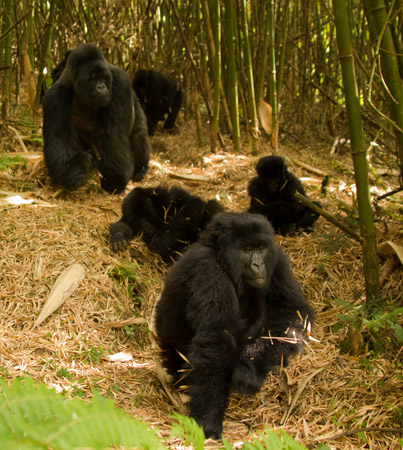
In May, look for our incredible portfolio.
We will be doing another Rwanda Mountain Gorilla
Photo Safaris
in November 2012.
Each trip is limited to SIX Participants and 5 Days of Trekking!
Contact our Office for more information.
These five treks marked our 61st through 65th Mountain Gorilla Treks in Rwanda, the most of any other individual, except actual researchers in Volcanoes National Park. We're proud of that record, and the number reflects our enthusiasm and excitement for photographing and visiting the Mountain Gorillas. In the Virunga Mastiff, the protected area of the Virunga Mountains shared by the Congo, Uganda, and Rwanda, only 480 gorillas still exist. Through tourism, however, the gorillas have enjoyed ever-increasing support and protection, and in seven years their numbers have increased by over 23%, with a greater than 3% annual population increase.
To paraphrase the comment of one of our participants from this season's trip, there is no other wildlife experience on earth that is as moving, as intimate, and as humbling. Imagine being inches from a 400 pound silverback gorilla, as it struts on by, with everyone squeezed along the trail edge to provide room. There is, by the way, a minimum distance tourists are supposed to be from the gorillas, but these great primates never read the rules, hence an experience like having a silverback being so close.
Images convey so much more than my words here, and while I kept a day-to-day journal, included below, it is brief. Frankly, at the end of a day, after editing images, I was bone tired and had little energy for writing. The images, however, should tell the story.....
Day 1. Nairobi to Kilgali to Gorilla View Lodge
Our travels went uneventfully, and we arrived at our lodge by 5PM. Our old lodge, the Gorilla Nest, had burned down shortly after our visit last year, although a small portion was still in operation. We worried that we'd be unhappy with a change, but as it turned out the new lodge, The Mountain Gorilla View Lodge, was a great upgrade.
The Gorilla View Lodge, was built by the original owners of the Gorilla Nest, but with improvements in mind. The rooms are huge, and the common area – the bar and dining area, are spacious. Paul, the owner, was there to greet us, and so were many of the old staff from the Nest, who were now now employed here. The lodge grounds overlooks all 6 volcanoes visible from this area, with a spectacular view of Sabyinyo and also of Mikeno, in the Congo. The 36 cottages are scattered along several trails, where thick native vegetation shields one room from another. Birds were abundant, and we saw more species here than I've seen anywhere else in Rwanda.
Day 2. Kwitonda Group
As I packed for our first shoot the previous evening, I was in crisis. I am a staunch believer in tripods, and regardless of the difficulty and occasionally cumbersome nature of a tripod in the thick bamboo and vegetation of Volcanoes National Park, I've always used my Gitzo. This year, however, I decided to take a risk and to use a Monopod. My reasoning: I could squeeze into smaller, tighter spots; I could adjust my camera position to the proper height while working with one leg; and I could move faster and travel lighter. Still, I was quite worried that I would not be steady enough, especially in low light situations. With that reservation in mind, I still chose the monopod for my first trek.
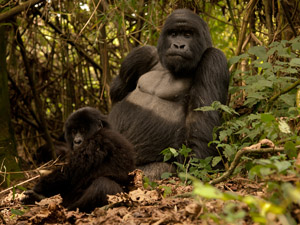
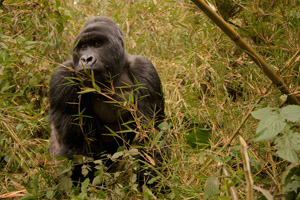
The lodge is busy, and getting eggs for breakfast is a bit of a rat-race with one cook and egg station, and for various reasons we were one of the last vehicles to leave for the Headquarters. Not that it mattered, for the first 15 minutes or so is spent in somewhat mindless milling about until the Park officials begin assigning groups.
Normally we have a favorite guide for our treks, but he was spoken for by a group of tourists involved with the Commonwealth Commission, and the President of Rwanda had suggested they have this veteran as their guide. Obviously, the President's request trumped our's, and we didn’t get him, but his replacement was excellent, speaking very good English, and he proved to be very accommodating on the hike and with the gorillas.
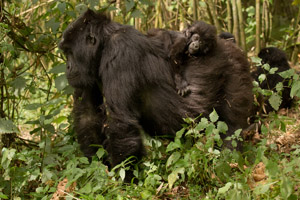
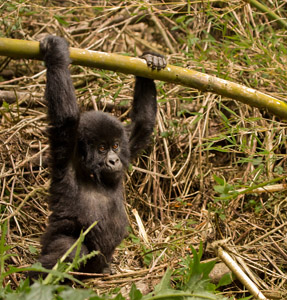
The Kwitonda group is large, with 22 members, including four silverbacks, one of which, Kwitonda, is the group’s namesake. The trek to the Park boundary, a stone fence that always reminds me of the barrier at Skull Island, blockading the monster ape King Kong, took about 45 minutes of easy but continual uphill hiking. Everyone in our group was very fit, and the trek was easy. We had another 40 minutes or so of trekking through the forest, composed of isolated stands of bamboo, mixed vegetation and trees, and some open clearings.
When we met the gorillas they were, by great good luck, in the clearings, feeding upon the sharply needled thistle plants. Although the gorillas were in a forest opening the area is by no means clear and open, it simply is free of bothersome shade trees. Much of the shrub growth grows 15 ft high, and almost all of the understory, composed of ferns, thistles, and less noxious weeds, grows at least waist high.
 Our first encounter was with a sleeping silverback, but it offered few useful shots, although for everyone, seeing their first huge gorilla had to be a real thrill. Behind the silverback a group of two and three year olds played, and a few people had some nice views of a 2 year old that posed atop a small tree. Periodically the baby would swing down and roll about the silverback, and although it was fun to see the baby offered nothing but a black round fur ball as it rolled about. Nearby, however, a one-eyed female sat completely in the open, plucking at thistles. Gorillas feed upon thistles by stripping the plant stem upwards, thus keeping the spikey, needle-like leaves from poking at their skin, or, while chewing, pointing the wrong way. The female made several comical poses as she fed, moving her mouth in Popeye-like grimaces.
Our first encounter was with a sleeping silverback, but it offered few useful shots, although for everyone, seeing their first huge gorilla had to be a real thrill. Behind the silverback a group of two and three year olds played, and a few people had some nice views of a 2 year old that posed atop a small tree. Periodically the baby would swing down and roll about the silverback, and although it was fun to see the baby offered nothing but a black round fur ball as it rolled about. Nearby, however, a one-eyed female sat completely in the open, plucking at thistles. Gorillas feed upon thistles by stripping the plant stem upwards, thus keeping the spikey, needle-like leaves from poking at their skin, or, while chewing, pointing the wrong way. The female made several comical poses as she fed, moving her mouth in Popeye-like grimaces.
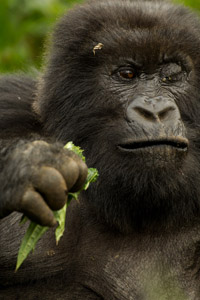 Later we had a great view of the silverback when it passed by us and sat in a broad, trampled-down opening, feeding once more upon thistles. At it left, the silverback walked within two feet of me, where I was squatted down for lower-level shots. I really expected to be shoved over or stood upon, but the silverback just walked on by.
Later we had a great view of the silverback when it passed by us and sat in a broad, trampled-down opening, feeding once more upon thistles. At it left, the silverback walked within two feet of me, where I was squatted down for lower-level shots. I really expected to be shoved over or stood upon, but the silverback just walked on by.
We had some great opportunities with a mother and young, again out in the open, and almost all of our shooting today was under cloudy bright light. Rarely, the sun popped out for some harsh conditions, but that never lasted long. The hour went by too quickly, which is the norm, but was, on our scale of 1-10, about a 7.5 or 8, with great lighting and good views and shooting of both silverbacks and mothers and young.
We arrived back to our vehicle by 12:30PM, and finished lunch by 2. The rest of the afternoon was spent wandering the grounds fruitlessly looking for chameleons, and downloading.
That evening, while editing my images and checking for critical sharpness at 100% in the RAW converter, I was pleased to see that using the monopod worked: my images were sharp. Further, all of the advantages I felt the monopod would offer proved to be true, and I resolved to use the monopod for the remainder of the trip.
Day 3. Agashya Group


The skies had a hint of a light overcast, and the valleys, normally sharply defined by dozens of hills rising from a bed of mist or smoke, were muted, making the entire area muted, appearing to be in a thermal inversion. We headed to a new group, Agashya, after exchanging guides at our lodge, as Alex, our usual guide, was very ill and needed to return to Kilgali.
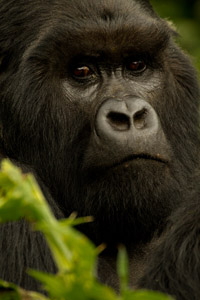
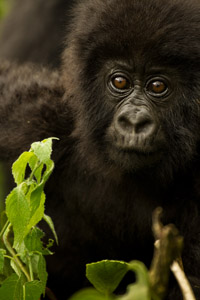
The hike to the forest was steep, about a 350 ft rise in elevation, but fairly easy, and from the stone fence the trek to the gorillas was less than 25 minutes. Our first encounter with the gorillas was discouraging, with a family group huddled beneath a huge tree and root mass that was in very dim light, but fortunately the group didn't stay there long. As the shoot progressed we had multiple opportunities for the silverback, Agashya, as well as very playful one or two year olds. We had several opportunities with females with babies, too, beginning almost immediately when three mothers walked passed us, and near the end of the shoot, another mother with a tiny infant on her back walked close by.
We considered the shoot tougher than yesterday because of the very close-quarters, requiring all of us to bunch up into small openings to shoot, and sometimes we were shooting in the dark bamboo thickets. Nonetheless, I’d give it at least a 8.5, for we had multiple great shooting opportunities and a lot of really interesting action. The hike was about a 3, on our scale of 1 to 10, with only the hiking through the farm fields being difficult.
On the way back I spotted a flap-necked chameleon, which Mark and Bob photographed. We arrived back at the lodge by 12:30, and used the next hour of generator time to download. In the late afternoon we photographed the troop of young Rwanda kids who perform some traditional dancing, with Sabyinyo, the volcano, in the background.
Day 4. Hirwa Group
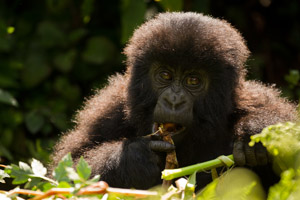

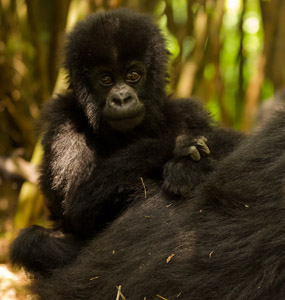 Unlike yesterday morning, today dawned clear and almost windless. After checking in, we headed to our departure point under almost perfectly clear skies, which boded poorly for the upcoming shoot. Ideal conditions for gorillas is cloudy bright, where the light is intense enough for good shutter speeds but muted, and producing no shadows. Under clear blue skies contrast can be a real problem, especially if the gorillas are in the forest.
Unlike yesterday morning, today dawned clear and almost windless. After checking in, we headed to our departure point under almost perfectly clear skies, which boded poorly for the upcoming shoot. Ideal conditions for gorillas is cloudy bright, where the light is intense enough for good shutter speeds but muted, and producing no shadows. Under clear blue skies contrast can be a real problem, especially if the gorillas are in the forest.
We hiked for about 50 minutes, an easy uphill climb, before heading into the forest. The trek was easy, and after about 45 minutes we reached the trackers. After grabbing our camera gear we started what would be the most difficult part of the entire trek, as we climbed down a small ravine and climbed up the other side before continuing uphill for about 200 yards.
The gorilla shoot was extremely fluid, where one moment the gorillas were in deep shade and the next in bright sunlight. Several times the huge lone silverback, Muninyo, walked by so close that he almost brushed us, and at one point he actually leaned against Bill. I had several close encounters, where we’d step off the trail to let the silverback gorilla pass, and one time, after he moved by, the silverback paused, as if he was still deciding whether to continue down the trail or to turn around and thump me. It was a tense, exciting couple of seconds, but really without much worry. In 63 treks, to date, I've only been pushed down twice, when a silverback pushed someone and, like a row of pins, several of us fell down in a cascading fall.

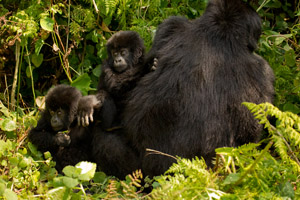
This group has a pair of 6 mo old twins, an extremely rare event amoung gorillas, and we had at least three shooting encounters with the twins and mother. Twin births, regardless of how rare, have little chance of survival, as a female usually carries her newborn cuddled in one arm as she walks three-legged through the forest. With two babies to hold on to, this becomes more difficult, and hence the low survival rate of twins. This pair was just the second time in 10 years that we've seen twins, the other being in the Susa group, and those twins survived. This year, we learned, the Susa group had another pair of twins as well.
Much of this shooting was very challenging – or taxing, with the groups in bright sunlight or in extremely dark lighting conditions. Looking at the images afterwards, however, we saw that we really had a very productive and diverse shoot, and one of the most productive we've ever had with babies, as they played or climbed trees, and, of course, the twins. The trek was about a 5 on our scale, and the shoot an easy 7 or greater, as the babies were incredible.
After a late lunch we left the lodge at 2:30PM for an afternoon shoot with the people. That went well, with plenty of kids, some women, and a great sequence with a log cutter.
Day 5. Sabyinyo Group
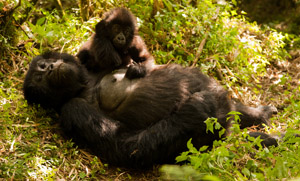
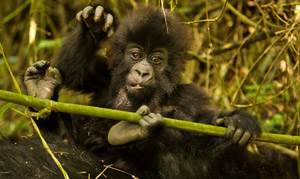
Another clear sky dawn. The hike was one of the easiest we've had, although my back problems kicked in for the first time and for a good part of the trek through the farms field I walked on numb legs, making foot placement a bit problematic. When we reached the uneven terrain of the forest my spine sorted itself out and I functioned normally, for what turned out to be a rather undemanding shoot.
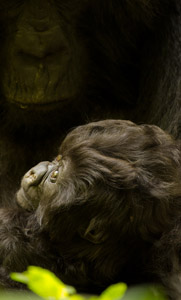
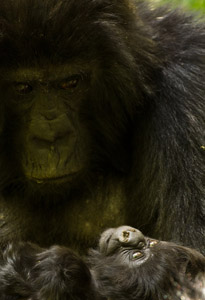

After getting our gear from our porters we descended, encountering a mother with a frisky baby that clambered about her on an open trail. The bright sunlight was blocked here by the canopy of bamboo, and we had rather uniform lighting. Later, when she moved down the trail and over a small ridge the mother and baby settled into a nice spot, although the shooting window was small, and I squeezed in to a tight spot between stems of bamboo while the baby played on its mother’s back.
 We were called off this pair because Guhonda, the largest and oldest silverback in the Volcanoes mastif, was sitting in the open. The lighting was extremely harsh, although the pose was good and tight face portraits were possible. Beside him, a female with a month-old baby lay resting, and although we tried several angles the shooting was a bit frustrating as the mother kept her back to us as she cradled the squirming infant. We circled through the bamboo for a front-end view, and I managed a few very tight shots, but had she sat up and nursed, or had the baby played, … it would have been terrific. At the end of our hour Guhonda got up and walked by us, and seconds later the female followed. Guhonda paused, looked back to be sure she was following, and moved down the trail. The trek was about a 3, but the shoot was only a 5.
We were called off this pair because Guhonda, the largest and oldest silverback in the Volcanoes mastif, was sitting in the open. The lighting was extremely harsh, although the pose was good and tight face portraits were possible. Beside him, a female with a month-old baby lay resting, and although we tried several angles the shooting was a bit frustrating as the mother kept her back to us as she cradled the squirming infant. We circled through the bamboo for a front-end view, and I managed a few very tight shots, but had she sat up and nursed, or had the baby played, … it would have been terrific. At the end of our hour Guhonda got up and walked by us, and seconds later the female followed. Guhonda paused, looked back to be sure she was following, and moved down the trail. The trek was about a 3, but the shoot was only a 5.
After lunch we headed for the Twin Lakes Overlook, despite the somewhat hazy conditions. One of the staff from the Virunga Hotel, perched atop the overlook, found a flap-necked chameleon, and we spent nearly an hour photographing in the shade of their parking lot. That night we tried shooting star-trails, but the half moon and the misty air foiled us, both by exposure -- we over-exposed, and by the mist fogging our lenses.
Day 6, Hirwa Group.
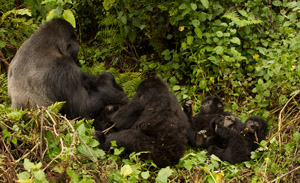
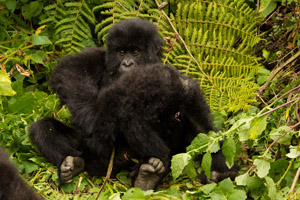
The skies were a bit more promising today, with a mackerel sky covering a portion of the sky scape. We decided on trying the Hirwa group again, hoping for another chance at the mother with twins. By the time we started our trek, however, most of the cloud cover was burned off and, once again, we started our hike through the farm fields under harsh, bright sunlight. Our trek took us into the bamboo, but when we arrived at the gorillas we were told that they were up in the trees and were hidden. We waited in the bamboo forest and every minute we lingered only added to our chances that the light would improve, as wisps of haze were beginning to soften the sky. Unfortunately it only took fifteen minutes until the gorillas descended and we grabbed our gear and headed for our shoot.
Our trek begin with the gorillas in the dark bamboo forest but fortunately the troop, led by the huge silverback, moved down the slope into a large open field, where for a few minutes we had perfect conditions – good light, and virtually no obstructing vegetation. After ten minutes or so the gorillas moved out of the clearing and back into the thick undergrowth. While that made the shooting a bit more difficult, or normal, at least they did not move back into the trees or into the thick and very dark bamboo forest. Still, the undergrowth was dense, and frequently, because of the thick vegetation we couldn’t see the gorillas when they were just a yard or so off the trail.
We were hoping for another session with the female and twins, as we had on our third day of trekking. We did see them, but the shooting was poor and our only good sighting occured when the trio walked by and into the thick cover of the undergrowth.
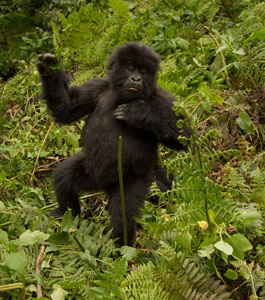
As our hour progressed a light cloud cover built up and we had the best lighting of the entire trip. The shooting ended up being extremely varied, with several great opportunities with the silverback, as well as shots of females and subadults feeding, and, to top it all off, we had much of the troop gathered in a clearing before us, where two young gorillas played and wrestled. All told, it was a wonderful climax to our five days of trekking. On our scale, the trek was about a 5, and the shooting a 9 -- a great shoot.
The afternoon was spent relaxing. I worked on some of the birds on the grounds, shooting robin-chats, bee-eaters, finches, and several sunbirds, and finally, after much searching, I found a chameleon on the lodge grounds. Dinner was a special bush dinner for our group held at the edge of the property,and the meal was followed by a comedic musician who admitted he didn’t know how to play the guitar as we sat in the warmth of a bonfire.
Day 7, back to Kilgali
We had a leisurely late breakfast before departing for Kilgali. En route we stopped at Park Headquarters where we picked up our 40 certificates of completion, and said goodbye to the Park personnel. The volcanoes stood starkly outlined against the blue sky, and with the bright, contrasty light that present, we were not sad at finally having to leave, or missing another trek.
Our drive back went without event, and at our hotel we met Alex, our original guide, who had now recovered from his sudden illness. Everyone was tired, but happy and satisfied, and Mary and I agreed that this was one of the five best gorilla trek sessions we have had in thirteen visits.
Each day, Mary and I shot about 20gb each, using cameras with a file size of 16mp. For the first time I used BREEZE BROWSER DOWNLOADER PRO to download my files, and I couldn't believe the speed of the file transfer, even with a USB 2 port. Once the images were downloaded, Mary and I would use Breeze Browser Pro for our first, rough edit, and generally we'd delete about 50% of the shoot in this first edit. Obviously, we overshot, or we're bad photographers ... but in this first edit we'd delete the poorly composed, badly focused, or simply missed images. Afterwards, we'd check for critical sharpness at 100% with the Adobe RAW converter.
We will be offering another Mountain Gorillas of Rwanda in the fall of 2012.
The brochure posted is for January 2012, and DOES NOT reflect recent price
increases, but otherwise the program and itinerary will be essentially the same.
Trip Report – Mountain Gorillas of Rwanda 2012

In May, look for our incredible portfolio.
We will be doing another Rwanda Mountain Gorilla
Photo Safaris
in November 2012.
Each trip is limited to SIX Participants and 5 Days of Trekking!
Contact our Office for more information.
These five treks marked our 61st through 65th Mountain Gorilla Treks in Rwanda, the most of any other individual, except actual researchers in Volcanoes National Park. We're proud of that record, and the number reflects our enthusiasm and excitement for photographing and visiting the Mountain Gorillas. In the Virunga Mastiff, the protected area of the Virunga Mountains shared by the Congo, Uganda, and Rwanda, only 480 gorillas still exist. Through tourism, however, the gorillas have enjoyed ever-increasing support and protection, and in seven years their numbers have increased by over 23%, with a greater than 3% annual population increase.
To paraphrase the comment of one of our participants from this season's trip, there is no other wildlife experience on earth that is as moving, as intimate, and as humbling. Imagine being inches from a 400 pound silverback gorilla, as it struts on by, with everyone squeezed along the trail edge to provide room. There is, by the way, a minimum distance tourists are supposed to be from the gorillas, but these great primates never read the rules, hence an experience like having a silverback being so close.
Images convey so much more than my words here, and while I kept a day-to-day journal, included below, it is brief. Frankly, at the end of a day, after editing images, I was bone tired and had little energy for writing. The images, however, should tell the story.....
Day 1. Nairobi to Kilgali to Gorilla View Lodge
Our travels went uneventfully, and we arrived at our lodge by 5PM. Our old lodge, the Gorilla Nest, had burned down shortly after our visit last year, although a small portion was still in operation. We worried that we'd be unhappy with a change, but as it turned out the new lodge, The Mountain Gorilla View Lodge, was a great upgrade.
The Gorilla View Lodge, was built by the original owners of the Gorilla Nest, but with improvements in mind. The rooms are huge, and the common area – the bar and dining area, are spacious. Paul, the owner, was there to greet us, and so were many of the old staff from the Nest, who were now now employed here. The lodge grounds overlooks all 6 volcanoes visible from this area, with a spectacular view of Sabyinyo and also of Mikeno, in the Congo. The 36 cottages are scattered along several trails, where thick native vegetation shields one room from another. Birds were abundant, and we saw more species here than I've seen anywhere else in Rwanda.
Day 2. Kwitonda Group
As I packed for our first shoot the previous evening, I was in crisis. I am a staunch believer in tripods, and regardless of the difficulty and occasionally cumbersome nature of a tripod in the thick bamboo and vegetation of Volcanoes National Park, I've always used my Gitzo. This year, however, I decided to take a risk and to use a Monopod. My reasoning: I could squeeze into smaller, tighter spots; I could adjust my camera position to the proper height while working with one leg; and I could move faster and travel lighter. Still, I was quite worried that I would not be steady enough, especially in low light situations. With that reservation in mind, I still chose the monopod for my first trek.


The lodge is busy, and getting eggs for breakfast is a bit of a rat-race with one cook and egg station, and for various reasons we were one of the last vehicles to leave for the Headquarters. Not that it mattered, for the first 15 minutes or so is spent in somewhat mindless milling about until the Park officials begin assigning groups.
Normally we have a favorite guide for our treks, but he was spoken for by a group of tourists involved with the Commonwealth Commission, and the President of Rwanda had suggested they have this veteran as their guide. Obviously, the President's request trumped our's, and we didn’t get him, but his replacement was excellent, speaking very good English, and he proved to be very accommodating on the hike and with the gorillas.


The Kwitonda group is large, with 22 members, including four silverbacks, one of which, Kwitonda, is the group’s namesake. The trek to the Park boundary, a stone fence that always reminds me of the barrier at Skull Island, blockading the monster ape King Kong, took about 45 minutes of easy but continual uphill hiking. Everyone in our group was very fit, and the trek was easy. We had another 40 minutes or so of trekking through the forest, composed of isolated stands of bamboo, mixed vegetation and trees, and some open clearings.
When we met the gorillas they were, by great good luck, in the clearings, feeding upon the sharply needled thistle plants. Although the gorillas were in a forest opening the area is by no means clear and open, it simply is free of bothersome shade trees. Much of the shrub growth grows 15 ft high, and almost all of the understory, composed of ferns, thistles, and less noxious weeds, grows at least waist high.
 Our first encounter was with a sleeping silverback, but it offered few useful shots, although for everyone, seeing their first huge gorilla had to be a real thrill. Behind the silverback a group of two and three year olds played, and a few people had some nice views of a 2 year old that posed atop a small tree. Periodically the baby would swing down and roll about the silverback, and although it was fun to see the baby offered nothing but a black round fur ball as it rolled about. Nearby, however, a one-eyed female sat completely in the open, plucking at thistles. Gorillas feed upon thistles by stripping the plant stem upwards, thus keeping the spikey, needle-like leaves from poking at their skin, or, while chewing, pointing the wrong way. The female made several comical poses as she fed, moving her mouth in Popeye-like grimaces.
Our first encounter was with a sleeping silverback, but it offered few useful shots, although for everyone, seeing their first huge gorilla had to be a real thrill. Behind the silverback a group of two and three year olds played, and a few people had some nice views of a 2 year old that posed atop a small tree. Periodically the baby would swing down and roll about the silverback, and although it was fun to see the baby offered nothing but a black round fur ball as it rolled about. Nearby, however, a one-eyed female sat completely in the open, plucking at thistles. Gorillas feed upon thistles by stripping the plant stem upwards, thus keeping the spikey, needle-like leaves from poking at their skin, or, while chewing, pointing the wrong way. The female made several comical poses as she fed, moving her mouth in Popeye-like grimaces.
 Later we had a great view of the silverback when it passed by us and sat in a broad, trampled-down opening, feeding once more upon thistles. At it left, the silverback walked within two feet of me, where I was squatted down for lower-level shots. I really expected to be shoved over or stood upon, but the silverback just walked on by.
Later we had a great view of the silverback when it passed by us and sat in a broad, trampled-down opening, feeding once more upon thistles. At it left, the silverback walked within two feet of me, where I was squatted down for lower-level shots. I really expected to be shoved over or stood upon, but the silverback just walked on by.
We had some great opportunities with a mother and young, again out in the open, and almost all of our shooting today was under cloudy bright light. Rarely, the sun popped out for some harsh conditions, but that never lasted long. The hour went by too quickly, which is the norm, but was, on our scale of 1-10, about a 7.5 or 8, with great lighting and good views and shooting of both silverbacks and mothers and young.
We arrived back to our vehicle by 12:30PM, and finished lunch by 2. The rest of the afternoon was spent wandering the grounds fruitlessly looking for chameleons, and downloading.
That evening, while editing my images and checking for critical sharpness at 100% in the RAW converter, I was pleased to see that using the monopod worked: my images were sharp. Further, all of the advantages I felt the monopod would offer proved to be true, and I resolved to use the monopod for the remainder of the trip.
Day 3. Agashya Group


The skies had a hint of a light overcast, and the valleys, normally sharply defined by dozens of hills rising from a bed of mist or smoke, were muted, making the entire area muted, appearing to be in a thermal inversion. We headed to a new group, Agashya, after exchanging guides at our lodge, as Alex, our usual guide, was very ill and needed to return to Kilgali.


The hike to the forest was steep, about a 350 ft rise in elevation, but fairly easy, and from the stone fence the trek to the gorillas was less than 25 minutes. Our first encounter with the gorillas was discouraging, with a family group huddled beneath a huge tree and root mass that was in very dim light, but fortunately the group didn't stay there long. As the shoot progressed we had multiple opportunities for the silverback, Agashya, as well as very playful one or two year olds. We had several opportunities with females with babies, too, beginning almost immediately when three mothers walked passed us, and near the end of the shoot, another mother with a tiny infant on her back walked close by.
We considered the shoot tougher than yesterday because of the very close-quarters, requiring all of us to bunch up into small openings to shoot, and sometimes we were shooting in the dark bamboo thickets. Nonetheless, I’d give it at least a 8.5, for we had multiple great shooting opportunities and a lot of really interesting action. The hike was about a 3, on our scale of 1 to 10, with only the hiking through the farm fields being difficult.
On the way back I spotted a flap-necked chameleon, which Mark and Bob photographed. We arrived back at the lodge by 12:30, and used the next hour of generator time to download. In the late afternoon we photographed the troop of young Rwanda kids who perform some traditional dancing, with Sabyinyo, the volcano, in the background.
Day 4. Hirwa Group


 Unlike yesterday morning, today dawned clear and almost windless. After checking in, we headed to our departure point under almost perfectly clear skies, which boded poorly for the upcoming shoot. Ideal conditions for gorillas is cloudy bright, where the light is intense enough for good shutter speeds but muted, and producing no shadows. Under clear blue skies contrast can be a real problem, especially if the gorillas are in the forest.
Unlike yesterday morning, today dawned clear and almost windless. After checking in, we headed to our departure point under almost perfectly clear skies, which boded poorly for the upcoming shoot. Ideal conditions for gorillas is cloudy bright, where the light is intense enough for good shutter speeds but muted, and producing no shadows. Under clear blue skies contrast can be a real problem, especially if the gorillas are in the forest.
We hiked for about 50 minutes, an easy uphill climb, before heading into the forest. The trek was easy, and after about 45 minutes we reached the trackers. After grabbing our camera gear we started what would be the most difficult part of the entire trek, as we climbed down a small ravine and climbed up the other side before continuing uphill for about 200 yards.
The gorilla shoot was extremely fluid, where one moment the gorillas were in deep shade and the next in bright sunlight. Several times the huge lone silverback, Muninyo, walked by so close that he almost brushed us, and at one point he actually leaned against Bill. I had several close encounters, where we’d step off the trail to let the silverback gorilla pass, and one time, after he moved by, the silverback paused, as if he was still deciding whether to continue down the trail or to turn around and thump me. It was a tense, exciting couple of seconds, but really without much worry. In 63 treks, to date, I've only been pushed down twice, when a silverback pushed someone and, like a row of pins, several of us fell down in a cascading fall.


This group has a pair of 6 mo old twins, an extremely rare event amoung gorillas, and we had at least three shooting encounters with the twins and mother. Twin births, regardless of how rare, have little chance of survival, as a female usually carries her newborn cuddled in one arm as she walks three-legged through the forest. With two babies to hold on to, this becomes more difficult, and hence the low survival rate of twins. This pair was just the second time in 10 years that we've seen twins, the other being in the Susa group, and those twins survived. This year, we learned, the Susa group had another pair of twins as well.
Much of this shooting was very challenging – or taxing, with the groups in bright sunlight or in extremely dark lighting conditions. Looking at the images afterwards, however, we saw that we really had a very productive and diverse shoot, and one of the most productive we've ever had with babies, as they played or climbed trees, and, of course, the twins. The trek was about a 5 on our scale, and the shoot an easy 7 or greater, as the babies were incredible.
After a late lunch we left the lodge at 2:30PM for an afternoon shoot with the people. That went well, with plenty of kids, some women, and a great sequence with a log cutter.
Day 5. Sabyinyo Group


Another clear sky dawn. The hike was one of the easiest we've had, although my back problems kicked in for the first time and for a good part of the trek through the farms field I walked on numb legs, making foot placement a bit problematic. When we reached the uneven terrain of the forest my spine sorted itself out and I functioned normally, for what turned out to be a rather undemanding shoot.



After getting our gear from our porters we descended, encountering a mother with a frisky baby that clambered about her on an open trail. The bright sunlight was blocked here by the canopy of bamboo, and we had rather uniform lighting. Later, when she moved down the trail and over a small ridge the mother and baby settled into a nice spot, although the shooting window was small, and I squeezed in to a tight spot between stems of bamboo while the baby played on its mother’s back.
 We were called off this pair because Guhonda, the largest and oldest silverback in the Volcanoes mastif, was sitting in the open. The lighting was extremely harsh, although the pose was good and tight face portraits were possible. Beside him, a female with a month-old baby lay resting, and although we tried several angles the shooting was a bit frustrating as the mother kept her back to us as she cradled the squirming infant. We circled through the bamboo for a front-end view, and I managed a few very tight shots, but had she sat up and nursed, or had the baby played, … it would have been terrific. At the end of our hour Guhonda got up and walked by us, and seconds later the female followed. Guhonda paused, looked back to be sure she was following, and moved down the trail. The trek was about a 3, but the shoot was only a 5.
We were called off this pair because Guhonda, the largest and oldest silverback in the Volcanoes mastif, was sitting in the open. The lighting was extremely harsh, although the pose was good and tight face portraits were possible. Beside him, a female with a month-old baby lay resting, and although we tried several angles the shooting was a bit frustrating as the mother kept her back to us as she cradled the squirming infant. We circled through the bamboo for a front-end view, and I managed a few very tight shots, but had she sat up and nursed, or had the baby played, … it would have been terrific. At the end of our hour Guhonda got up and walked by us, and seconds later the female followed. Guhonda paused, looked back to be sure she was following, and moved down the trail. The trek was about a 3, but the shoot was only a 5.
After lunch we headed for the Twin Lakes Overlook, despite the somewhat hazy conditions. One of the staff from the Virunga Hotel, perched atop the overlook, found a flap-necked chameleon, and we spent nearly an hour photographing in the shade of their parking lot. That night we tried shooting star-trails, but the half moon and the misty air foiled us, both by exposure -- we over-exposed, and by the mist fogging our lenses.
Day 6, Hirwa Group.


The skies were a bit more promising today, with a mackerel sky covering a portion of the sky scape. We decided on trying the Hirwa group again, hoping for another chance at the mother with twins. By the time we started our trek, however, most of the cloud cover was burned off and, once again, we started our hike through the farm fields under harsh, bright sunlight. Our trek took us into the bamboo, but when we arrived at the gorillas we were told that they were up in the trees and were hidden. We waited in the bamboo forest and every minute we lingered only added to our chances that the light would improve, as wisps of haze were beginning to soften the sky. Unfortunately it only took fifteen minutes until the gorillas descended and we grabbed our gear and headed for our shoot.
Our trek begin with the gorillas in the dark bamboo forest but fortunately the troop, led by the huge silverback, moved down the slope into a large open field, where for a few minutes we had perfect conditions – good light, and virtually no obstructing vegetation. After ten minutes or so the gorillas moved out of the clearing and back into the thick undergrowth. While that made the shooting a bit more difficult, or normal, at least they did not move back into the trees or into the thick and very dark bamboo forest. Still, the undergrowth was dense, and frequently, because of the thick vegetation we couldn’t see the gorillas when they were just a yard or so off the trail.
We were hoping for another session with the female and twins, as we had on our third day of trekking. We did see them, but the shooting was poor and our only good sighting occured when the trio walked by and into the thick cover of the undergrowth.

As our hour progressed a light cloud cover built up and we had the best lighting of the entire trip. The shooting ended up being extremely varied, with several great opportunities with the silverback, as well as shots of females and subadults feeding, and, to top it all off, we had much of the troop gathered in a clearing before us, where two young gorillas played and wrestled. All told, it was a wonderful climax to our five days of trekking. On our scale, the trek was about a 5, and the shooting a 9 -- a great shoot.
The afternoon was spent relaxing. I worked on some of the birds on the grounds, shooting robin-chats, bee-eaters, finches, and several sunbirds, and finally, after much searching, I found a chameleon on the lodge grounds. Dinner was a special bush dinner for our group held at the edge of the property,and the meal was followed by a comedic musician who admitted he didn’t know how to play the guitar as we sat in the warmth of a bonfire.
Day 7, back to Kilgali
We had a leisurely late breakfast before departing for Kilgali. En route we stopped at Park Headquarters where we picked up our 40 certificates of completion, and said goodbye to the Park personnel. The volcanoes stood starkly outlined against the blue sky, and with the bright, contrasty light that present, we were not sad at finally having to leave, or missing another trek.
Our drive back went without event, and at our hotel we met Alex, our original guide, who had now recovered from his sudden illness. Everyone was tired, but happy and satisfied, and Mary and I agreed that this was one of the five best gorilla trek sessions we have had in thirteen visits.
Each day, Mary and I shot about 20gb each, using cameras with a file size of 16mp. For the first time I used BREEZE BROWSER DOWNLOADER PRO to download my files, and I couldn't believe the speed of the file transfer, even with a USB 2 port. Once the images were downloaded, Mary and I would use Breeze Browser Pro for our first, rough edit, and generally we'd delete about 50% of the shoot in this first edit. Obviously, we overshot, or we're bad photographers ... but in this first edit we'd delete the poorly composed, badly focused, or simply missed images. Afterwards, we'd check for critical sharpness at 100% with the Adobe RAW converter.
We will be offering another Mountain Gorillas of Rwanda in the fall of 2012.
The brochure posted is for January 2012, and DOES NOT reflect recent price
increases, but otherwise the program and itinerary will be essentially the same.
Trip Report – Mountain Gorillas of Rwanda 2012

In May, look for our incredible portfolio.
We will be doing another Rwanda Mountain Gorilla
Photo Safaris
in November 2012.
Each trip is limited to SIX Participants and 5 Days of Trekking!
Contact our Office for more information.
These five treks marked our 61st through 65th Mountain Gorilla Treks in Rwanda, the most of any other individual, except actual researchers in Volcanoes National Park. We're proud of that record, and the number reflects our enthusiasm and excitement for photographing and visiting the Mountain Gorillas. In the Virunga Mastiff, the protected area of the Virunga Mountains shared by the Congo, Uganda, and Rwanda, only 480 gorillas still exist. Through tourism, however, the gorillas have enjoyed ever-increasing support and protection, and in seven years their numbers have increased by over 23%, with a greater than 3% annual population increase.
To paraphrase the comment of one of our participants from this season's trip, there is no other wildlife experience on earth that is as moving, as intimate, and as humbling. Imagine being inches from a 400 pound silverback gorilla, as it struts on by, with everyone squeezed along the trail edge to provide room. There is, by the way, a minimum distance tourists are supposed to be from the gorillas, but these great primates never read the rules, hence an experience like having a silverback being so close.
Images convey so much more than my words here, and while I kept a day-to-day journal, included below, it is brief. Frankly, at the end of a day, after editing images, I was bone tired and had little energy for writing. The images, however, should tell the story.....
Day 1. Nairobi to Kilgali to Gorilla View Lodge
Our travels went uneventfully, and we arrived at our lodge by 5PM. Our old lodge, the Gorilla Nest, had burned down shortly after our visit last year, although a small portion was still in operation. We worried that we'd be unhappy with a change, but as it turned out the new lodge, The Mountain Gorilla View Lodge, was a great upgrade.
The Gorilla View Lodge, was built by the original owners of the Gorilla Nest, but with improvements in mind. The rooms are huge, and the common area – the bar and dining area, are spacious. Paul, the owner, was there to greet us, and so were many of the old staff from the Nest, who were now now employed here. The lodge grounds overlooks all 6 volcanoes visible from this area, with a spectacular view of Sabyinyo and also of Mikeno, in the Congo. The 36 cottages are scattered along several trails, where thick native vegetation shields one room from another. Birds were abundant, and we saw more species here than I've seen anywhere else in Rwanda.
Day 2. Kwitonda Group
As I packed for our first shoot the previous evening, I was in crisis. I am a staunch believer in tripods, and regardless of the difficulty and occasionally cumbersome nature of a tripod in the thick bamboo and vegetation of Volcanoes National Park, I've always used my Gitzo. This year, however, I decided to take a risk and to use a Monopod. My reasoning: I could squeeze into smaller, tighter spots; I could adjust my camera position to the proper height while working with one leg; and I could move faster and travel lighter. Still, I was quite worried that I would not be steady enough, especially in low light situations. With that reservation in mind, I still chose the monopod for my first trek.


The lodge is busy, and getting eggs for breakfast is a bit of a rat-race with one cook and egg station, and for various reasons we were one of the last vehicles to leave for the Headquarters. Not that it mattered, for the first 15 minutes or so is spent in somewhat mindless milling about until the Park officials begin assigning groups.
Normally we have a favorite guide for our treks, but he was spoken for by a group of tourists involved with the Commonwealth Commission, and the President of Rwanda had suggested they have this veteran as their guide. Obviously, the President's request trumped our's, and we didn’t get him, but his replacement was excellent, speaking very good English, and he proved to be very accommodating on the hike and with the gorillas.


The Kwitonda group is large, with 22 members, including four silverbacks, one of which, Kwitonda, is the group’s namesake. The trek to the Park boundary, a stone fence that always reminds me of the barrier at Skull Island, blockading the monster ape King Kong, took about 45 minutes of easy but continual uphill hiking. Everyone in our group was very fit, and the trek was easy. We had another 40 minutes or so of trekking through the forest, composed of isolated stands of bamboo, mixed vegetation and trees, and some open clearings.
When we met the gorillas they were, by great good luck, in the clearings, feeding upon the sharply needled thistle plants. Although the gorillas were in a forest opening the area is by no means clear and open, it simply is free of bothersome shade trees. Much of the shrub growth grows 15 ft high, and almost all of the understory, composed of ferns, thistles, and less noxious weeds, grows at least waist high.
 Our first encounter was with a sleeping silverback, but it offered few useful shots, although for everyone, seeing their first huge gorilla had to be a real thrill. Behind the silverback a group of two and three year olds played, and a few people had some nice views of a 2 year old that posed atop a small tree. Periodically the baby would swing down and roll about the silverback, and although it was fun to see the baby offered nothing but a black round fur ball as it rolled about. Nearby, however, a one-eyed female sat completely in the open, plucking at thistles. Gorillas feed upon thistles by stripping the plant stem upwards, thus keeping the spikey, needle-like leaves from poking at their skin, or, while chewing, pointing the wrong way. The female made several comical poses as she fed, moving her mouth in Popeye-like grimaces.
Our first encounter was with a sleeping silverback, but it offered few useful shots, although for everyone, seeing their first huge gorilla had to be a real thrill. Behind the silverback a group of two and three year olds played, and a few people had some nice views of a 2 year old that posed atop a small tree. Periodically the baby would swing down and roll about the silverback, and although it was fun to see the baby offered nothing but a black round fur ball as it rolled about. Nearby, however, a one-eyed female sat completely in the open, plucking at thistles. Gorillas feed upon thistles by stripping the plant stem upwards, thus keeping the spikey, needle-like leaves from poking at their skin, or, while chewing, pointing the wrong way. The female made several comical poses as she fed, moving her mouth in Popeye-like grimaces.
 Later we had a great view of the silverback when it passed by us and sat in a broad, trampled-down opening, feeding once more upon thistles. At it left, the silverback walked within two feet of me, where I was squatted down for lower-level shots. I really expected to be shoved over or stood upon, but the silverback just walked on by.
Later we had a great view of the silverback when it passed by us and sat in a broad, trampled-down opening, feeding once more upon thistles. At it left, the silverback walked within two feet of me, where I was squatted down for lower-level shots. I really expected to be shoved over or stood upon, but the silverback just walked on by.
We had some great opportunities with a mother and young, again out in the open, and almost all of our shooting today was under cloudy bright light. Rarely, the sun popped out for some harsh conditions, but that never lasted long. The hour went by too quickly, which is the norm, but was, on our scale of 1-10, about a 7.5 or 8, with great lighting and good views and shooting of both silverbacks and mothers and young.
We arrived back to our vehicle by 12:30PM, and finished lunch by 2. The rest of the afternoon was spent wandering the grounds fruitlessly looking for chameleons, and downloading.
That evening, while editing my images and checking for critical sharpness at 100% in the RAW converter, I was pleased to see that using the monopod worked: my images were sharp. Further, all of the advantages I felt the monopod would offer proved to be true, and I resolved to use the monopod for the remainder of the trip.
Day 3. Agashya Group


The skies had a hint of a light overcast, and the valleys, normally sharply defined by dozens of hills rising from a bed of mist or smoke, were muted, making the entire area muted, appearing to be in a thermal inversion. We headed to a new group, Agashya, after exchanging guides at our lodge, as Alex, our usual guide, was very ill and needed to return to Kilgali.


The hike to the forest was steep, about a 350 ft rise in elevation, but fairly easy, and from the stone fence the trek to the gorillas was less than 25 minutes. Our first encounter with the gorillas was discouraging, with a family group huddled beneath a huge tree and root mass that was in very dim light, but fortunately the group didn't stay there long. As the shoot progressed we had multiple opportunities for the silverback, Agashya, as well as very playful one or two year olds. We had several opportunities with females with babies, too, beginning almost immediately when three mothers walked passed us, and near the end of the shoot, another mother with a tiny infant on her back walked close by.
We considered the shoot tougher than yesterday because of the very close-quarters, requiring all of us to bunch up into small openings to shoot, and sometimes we were shooting in the dark bamboo thickets. Nonetheless, I’d give it at least a 8.5, for we had multiple great shooting opportunities and a lot of really interesting action. The hike was about a 3, on our scale of 1 to 10, with only the hiking through the farm fields being difficult.
On the way back I spotted a flap-necked chameleon, which Mark and Bob photographed. We arrived back at the lodge by 12:30, and used the next hour of generator time to download. In the late afternoon we photographed the troop of young Rwanda kids who perform some traditional dancing, with Sabyinyo, the volcano, in the background.
Day 4. Hirwa Group


 Unlike yesterday morning, today dawned clear and almost windless. After checking in, we headed to our departure point under almost perfectly clear skies, which boded poorly for the upcoming shoot. Ideal conditions for gorillas is cloudy bright, where the light is intense enough for good shutter speeds but muted, and producing no shadows. Under clear blue skies contrast can be a real problem, especially if the gorillas are in the forest.
Unlike yesterday morning, today dawned clear and almost windless. After checking in, we headed to our departure point under almost perfectly clear skies, which boded poorly for the upcoming shoot. Ideal conditions for gorillas is cloudy bright, where the light is intense enough for good shutter speeds but muted, and producing no shadows. Under clear blue skies contrast can be a real problem, especially if the gorillas are in the forest.
We hiked for about 50 minutes, an easy uphill climb, before heading into the forest. The trek was easy, and after about 45 minutes we reached the trackers. After grabbing our camera gear we started what would be the most difficult part of the entire trek, as we climbed down a small ravine and climbed up the other side before continuing uphill for about 200 yards.
The gorilla shoot was extremely fluid, where one moment the gorillas were in deep shade and the next in bright sunlight. Several times the huge lone silverback, Muninyo, walked by so close that he almost brushed us, and at one point he actually leaned against Bill. I had several close encounters, where we’d step off the trail to let the silverback gorilla pass, and one time, after he moved by, the silverback paused, as if he was still deciding whether to continue down the trail or to turn around and thump me. It was a tense, exciting couple of seconds, but really without much worry. In 63 treks, to date, I've only been pushed down twice, when a silverback pushed someone and, like a row of pins, several of us fell down in a cascading fall.


This group has a pair of 6 mo old twins, an extremely rare event amoung gorillas, and we had at least three shooting encounters with the twins and mother. Twin births, regardless of how rare, have little chance of survival, as a female usually carries her newborn cuddled in one arm as she walks three-legged through the forest. With two babies to hold on to, this becomes more difficult, and hence the low survival rate of twins. This pair was just the second time in 10 years that we've seen twins, the other being in the Susa group, and those twins survived. This year, we learned, the Susa group had another pair of twins as well.
Much of this shooting was very challenging – or taxing, with the groups in bright sunlight or in extremely dark lighting conditions. Looking at the images afterwards, however, we saw that we really had a very productive and diverse shoot, and one of the most productive we've ever had with babies, as they played or climbed trees, and, of course, the twins. The trek was about a 5 on our scale, and the shoot an easy 7 or greater, as the babies were incredible.
After a late lunch we left the lodge at 2:30PM for an afternoon shoot with the people. That went well, with plenty of kids, some women, and a great sequence with a log cutter.
Day 5. Sabyinyo Group


Another clear sky dawn. The hike was one of the easiest we've had, although my back problems kicked in for the first time and for a good part of the trek through the farms field I walked on numb legs, making foot placement a bit problematic. When we reached the uneven terrain of the forest my spine sorted itself out and I functioned normally, for what turned out to be a rather undemanding shoot.



After getting our gear from our porters we descended, encountering a mother with a frisky baby that clambered about her on an open trail. The bright sunlight was blocked here by the canopy of bamboo, and we had rather uniform lighting. Later, when she moved down the trail and over a small ridge the mother and baby settled into a nice spot, although the shooting window was small, and I squeezed in to a tight spot between stems of bamboo while the baby played on its mother’s back.
 We were called off this pair because Guhonda, the largest and oldest silverback in the Volcanoes mastif, was sitting in the open. The lighting was extremely harsh, although the pose was good and tight face portraits were possible. Beside him, a female with a month-old baby lay resting, and although we tried several angles the shooting was a bit frustrating as the mother kept her back to us as she cradled the squirming infant. We circled through the bamboo for a front-end view, and I managed a few very tight shots, but had she sat up and nursed, or had the baby played, … it would have been terrific. At the end of our hour Guhonda got up and walked by us, and seconds later the female followed. Guhonda paused, looked back to be sure she was following, and moved down the trail. The trek was about a 3, but the shoot was only a 5.
We were called off this pair because Guhonda, the largest and oldest silverback in the Volcanoes mastif, was sitting in the open. The lighting was extremely harsh, although the pose was good and tight face portraits were possible. Beside him, a female with a month-old baby lay resting, and although we tried several angles the shooting was a bit frustrating as the mother kept her back to us as she cradled the squirming infant. We circled through the bamboo for a front-end view, and I managed a few very tight shots, but had she sat up and nursed, or had the baby played, … it would have been terrific. At the end of our hour Guhonda got up and walked by us, and seconds later the female followed. Guhonda paused, looked back to be sure she was following, and moved down the trail. The trek was about a 3, but the shoot was only a 5.
After lunch we headed for the Twin Lakes Overlook, despite the somewhat hazy conditions. One of the staff from the Virunga Hotel, perched atop the overlook, found a flap-necked chameleon, and we spent nearly an hour photographing in the shade of their parking lot. That night we tried shooting star-trails, but the half moon and the misty air foiled us, both by exposure -- we over-exposed, and by the mist fogging our lenses.
Day 6, Hirwa Group.


The skies were a bit more promising today, with a mackerel sky covering a portion of the sky scape. We decided on trying the Hirwa group again, hoping for another chance at the mother with twins. By the time we started our trek, however, most of the cloud cover was burned off and, once again, we started our hike through the farm fields under harsh, bright sunlight. Our trek took us into the bamboo, but when we arrived at the gorillas we were told that they were up in the trees and were hidden. We waited in the bamboo forest and every minute we lingered only added to our chances that the light would improve, as wisps of haze were beginning to soften the sky. Unfortunately it only took fifteen minutes until the gorillas descended and we grabbed our gear and headed for our shoot.
Our trek begin with the gorillas in the dark bamboo forest but fortunately the troop, led by the huge silverback, moved down the slope into a large open field, where for a few minutes we had perfect conditions – good light, and virtually no obstructing vegetation. After ten minutes or so the gorillas moved out of the clearing and back into the thick undergrowth. While that made the shooting a bit more difficult, or normal, at least they did not move back into the trees or into the thick and very dark bamboo forest. Still, the undergrowth was dense, and frequently, because of the thick vegetation we couldn’t see the gorillas when they were just a yard or so off the trail.
We were hoping for another session with the female and twins, as we had on our third day of trekking. We did see them, but the shooting was poor and our only good sighting occured when the trio walked by and into the thick cover of the undergrowth.

As our hour progressed a light cloud cover built up and we had the best lighting of the entire trip. The shooting ended up being extremely varied, with several great opportunities with the silverback, as well as shots of females and subadults feeding, and, to top it all off, we had much of the troop gathered in a clearing before us, where two young gorillas played and wrestled. All told, it was a wonderful climax to our five days of trekking. On our scale, the trek was about a 5, and the shooting a 9 -- a great shoot.
The afternoon was spent relaxing. I worked on some of the birds on the grounds, shooting robin-chats, bee-eaters, finches, and several sunbirds, and finally, after much searching, I found a chameleon on the lodge grounds. Dinner was a special bush dinner for our group held at the edge of the property,and the meal was followed by a comedic musician who admitted he didn’t know how to play the guitar as we sat in the warmth of a bonfire.
Day 7, back to Kilgali
We had a leisurely late breakfast before departing for Kilgali. En route we stopped at Park Headquarters where we picked up our 40 certificates of completion, and said goodbye to the Park personnel. The volcanoes stood starkly outlined against the blue sky, and with the bright, contrasty light that present, we were not sad at finally having to leave, or missing another trek.
Our drive back went without event, and at our hotel we met Alex, our original guide, who had now recovered from his sudden illness. Everyone was tired, but happy and satisfied, and Mary and I agreed that this was one of the five best gorilla trek sessions we have had in thirteen visits.
Each day, Mary and I shot about 20gb each, using cameras with a file size of 16mp. For the first time I used BREEZE BROWSER DOWNLOADER PRO to download my files, and I couldn't believe the speed of the file transfer, even with a USB 2 port. Once the images were downloaded, Mary and I would use Breeze Browser Pro for our first, rough edit, and generally we'd delete about 50% of the shoot in this first edit. Obviously, we overshot, or we're bad photographers ... but in this first edit we'd delete the poorly composed, badly focused, or simply missed images. Afterwards, we'd check for critical sharpness at 100% with the Adobe RAW converter.
We will be offering another Mountain Gorillas of Rwanda in the fall of 2012.
The brochure posted is for January 2012, and DOES NOT reflect recent price
increases, but otherwise the program and itinerary will be essentially the same.
Trip Report – Mountain Gorillas of Rwanda 2012

In May, look for our incredible portfolio.
We will be doing another Rwanda Mountain Gorilla
Photo Safaris
in November 2012.
Each trip is limited to SIX Participants and 5 Days of Trekking!
Contact our Office for more information.
These five treks marked our 61st through 65th Mountain Gorilla Treks in Rwanda, the most of any other individual, except actual researchers in Volcanoes National Park. We're proud of that record, and the number reflects our enthusiasm and excitement for photographing and visiting the Mountain Gorillas. In the Virunga Mastiff, the protected area of the Virunga Mountains shared by the Congo, Uganda, and Rwanda, only 480 gorillas still exist. Through tourism, however, the gorillas have enjoyed ever-increasing support and protection, and in seven years their numbers have increased by over 23%, with a greater than 3% annual population increase.
To paraphrase the comment of one of our participants from this season's trip, there is no other wildlife experience on earth that is as moving, as intimate, and as humbling. Imagine being inches from a 400 pound silverback gorilla, as it struts on by, with everyone squeezed along the trail edge to provide room. There is, by the way, a minimum distance tourists are supposed to be from the gorillas, but these great primates never read the rules, hence an experience like having a silverback being so close.
Images convey so much more than my words here, and while I kept a day-to-day journal, included below, it is brief. Frankly, at the end of a day, after editing images, I was bone tired and had little energy for writing. The images, however, should tell the story.....
Day 1. Nairobi to Kilgali to Gorilla View Lodge
Our travels went uneventfully, and we arrived at our lodge by 5PM. Our old lodge, the Gorilla Nest, had burned down shortly after our visit last year, although a small portion was still in operation. We worried that we'd be unhappy with a change, but as it turned out the new lodge, The Mountain Gorilla View Lodge, was a great upgrade.
The Gorilla View Lodge, was built by the original owners of the Gorilla Nest, but with improvements in mind. The rooms are huge, and the common area – the bar and dining area, are spacious. Paul, the owner, was there to greet us, and so were many of the old staff from the Nest, who were now now employed here. The lodge grounds overlooks all 6 volcanoes visible from this area, with a spectacular view of Sabyinyo and also of Mikeno, in the Congo. The 36 cottages are scattered along several trails, where thick native vegetation shields one room from another. Birds were abundant, and we saw more species here than I've seen anywhere else in Rwanda.
Day 2. Kwitonda Group
As I packed for our first shoot the previous evening, I was in crisis. I am a staunch believer in tripods, and regardless of the difficulty and occasionally cumbersome nature of a tripod in the thick bamboo and vegetation of Volcanoes National Park, I've always used my Gitzo. This year, however, I decided to take a risk and to use a Monopod. My reasoning: I could squeeze into smaller, tighter spots; I could adjust my camera position to the proper height while working with one leg; and I could move faster and travel lighter. Still, I was quite worried that I would not be steady enough, especially in low light situations. With that reservation in mind, I still chose the monopod for my first trek.


The lodge is busy, and getting eggs for breakfast is a bit of a rat-race with one cook and egg station, and for various reasons we were one of the last vehicles to leave for the Headquarters. Not that it mattered, for the first 15 minutes or so is spent in somewhat mindless milling about until the Park officials begin assigning groups.
Normally we have a favorite guide for our treks, but he was spoken for by a group of tourists involved with the Commonwealth Commission, and the President of Rwanda had suggested they have this veteran as their guide. Obviously, the President's request trumped our's, and we didn’t get him, but his replacement was excellent, speaking very good English, and he proved to be very accommodating on the hike and with the gorillas.


The Kwitonda group is large, with 22 members, including four silverbacks, one of which, Kwitonda, is the group’s namesake. The trek to the Park boundary, a stone fence that always reminds me of the barrier at Skull Island, blockading the monster ape King Kong, took about 45 minutes of easy but continual uphill hiking. Everyone in our group was very fit, and the trek was easy. We had another 40 minutes or so of trekking through the forest, composed of isolated stands of bamboo, mixed vegetation and trees, and some open clearings.
When we met the gorillas they were, by great good luck, in the clearings, feeding upon the sharply needled thistle plants. Although the gorillas were in a forest opening the area is by no means clear and open, it simply is free of bothersome shade trees. Much of the shrub growth grows 15 ft high, and almost all of the understory, composed of ferns, thistles, and less noxious weeds, grows at least waist high.
 Our first encounter was with a sleeping silverback, but it offered few useful shots, although for everyone, seeing their first huge gorilla had to be a real thrill. Behind the silverback a group of two and three year olds played, and a few people had some nice views of a 2 year old that posed atop a small tree. Periodically the baby would swing down and roll about the silverback, and although it was fun to see the baby offered nothing but a black round fur ball as it rolled about. Nearby, however, a one-eyed female sat completely in the open, plucking at thistles. Gorillas feed upon thistles by stripping the plant stem upwards, thus keeping the spikey, needle-like leaves from poking at their skin, or, while chewing, pointing the wrong way. The female made several comical poses as she fed, moving her mouth in Popeye-like grimaces.
Our first encounter was with a sleeping silverback, but it offered few useful shots, although for everyone, seeing their first huge gorilla had to be a real thrill. Behind the silverback a group of two and three year olds played, and a few people had some nice views of a 2 year old that posed atop a small tree. Periodically the baby would swing down and roll about the silverback, and although it was fun to see the baby offered nothing but a black round fur ball as it rolled about. Nearby, however, a one-eyed female sat completely in the open, plucking at thistles. Gorillas feed upon thistles by stripping the plant stem upwards, thus keeping the spikey, needle-like leaves from poking at their skin, or, while chewing, pointing the wrong way. The female made several comical poses as she fed, moving her mouth in Popeye-like grimaces.
 Later we had a great view of the silverback when it passed by us and sat in a broad, trampled-down opening, feeding once more upon thistles. At it left, the silverback walked within two feet of me, where I was squatted down for lower-level shots. I really expected to be shoved over or stood upon, but the silverback just walked on by.
Later we had a great view of the silverback when it passed by us and sat in a broad, trampled-down opening, feeding once more upon thistles. At it left, the silverback walked within two feet of me, where I was squatted down for lower-level shots. I really expected to be shoved over or stood upon, but the silverback just walked on by.
We had some great opportunities with a mother and young, again out in the open, and almost all of our shooting today was under cloudy bright light. Rarely, the sun popped out for some harsh conditions, but that never lasted long. The hour went by too quickly, which is the norm, but was, on our scale of 1-10, about a 7.5 or 8, with great lighting and good views and shooting of both silverbacks and mothers and young.
We arrived back to our vehicle by 12:30PM, and finished lunch by 2. The rest of the afternoon was spent wandering the grounds fruitlessly looking for chameleons, and downloading.
That evening, while editing my images and checking for critical sharpness at 100% in the RAW converter, I was pleased to see that using the monopod worked: my images were sharp. Further, all of the advantages I felt the monopod would offer proved to be true, and I resolved to use the monopod for the remainder of the trip.
Day 3. Agashya Group


The skies had a hint of a light overcast, and the valleys, normally sharply defined by dozens of hills rising from a bed of mist or smoke, were muted, making the entire area muted, appearing to be in a thermal inversion. We headed to a new group, Agashya, after exchanging guides at our lodge, as Alex, our usual guide, was very ill and needed to return to Kilgali.


The hike to the forest was steep, about a 350 ft rise in elevation, but fairly easy, and from the stone fence the trek to the gorillas was less than 25 minutes. Our first encounter with the gorillas was discouraging, with a family group huddled beneath a huge tree and root mass that was in very dim light, but fortunately the group didn't stay there long. As the shoot progressed we had multiple opportunities for the silverback, Agashya, as well as very playful one or two year olds. We had several opportunities with females with babies, too, beginning almost immediately when three mothers walked passed us, and near the end of the shoot, another mother with a tiny infant on her back walked close by.
We considered the shoot tougher than yesterday because of the very close-quarters, requiring all of us to bunch up into small openings to shoot, and sometimes we were shooting in the dark bamboo thickets. Nonetheless, I’d give it at least a 8.5, for we had multiple great shooting opportunities and a lot of really interesting action. The hike was about a 3, on our scale of 1 to 10, with only the hiking through the farm fields being difficult.
On the way back I spotted a flap-necked chameleon, which Mark and Bob photographed. We arrived back at the lodge by 12:30, and used the next hour of generator time to download. In the late afternoon we photographed the troop of young Rwanda kids who perform some traditional dancing, with Sabyinyo, the volcano, in the background.
Day 4. Hirwa Group


 Unlike yesterday morning, today dawned clear and almost windless. After checking in, we headed to our departure point under almost perfectly clear skies, which boded poorly for the upcoming shoot. Ideal conditions for gorillas is cloudy bright, where the light is intense enough for good shutter speeds but muted, and producing no shadows. Under clear blue skies contrast can be a real problem, especially if the gorillas are in the forest.
Unlike yesterday morning, today dawned clear and almost windless. After checking in, we headed to our departure point under almost perfectly clear skies, which boded poorly for the upcoming shoot. Ideal conditions for gorillas is cloudy bright, where the light is intense enough for good shutter speeds but muted, and producing no shadows. Under clear blue skies contrast can be a real problem, especially if the gorillas are in the forest.
We hiked for about 50 minutes, an easy uphill climb, before heading into the forest. The trek was easy, and after about 45 minutes we reached the trackers. After grabbing our camera gear we started what would be the most difficult part of the entire trek, as we climbed down a small ravine and climbed up the other side before continuing uphill for about 200 yards.
The gorilla shoot was extremely fluid, where one moment the gorillas were in deep shade and the next in bright sunlight. Several times the huge lone silverback, Muninyo, walked by so close that he almost brushed us, and at one point he actually leaned against Bill. I had several close encounters, where we’d step off the trail to let the silverback gorilla pass, and one time, after he moved by, the silverback paused, as if he was still deciding whether to continue down the trail or to turn around and thump me. It was a tense, exciting couple of seconds, but really without much worry. In 63 treks, to date, I've only been pushed down twice, when a silverback pushed someone and, like a row of pins, several of us fell down in a cascading fall.


This group has a pair of 6 mo old twins, an extremely rare event amoung gorillas, and we had at least three shooting encounters with the twins and mother. Twin births, regardless of how rare, have little chance of survival, as a female usually carries her newborn cuddled in one arm as she walks three-legged through the forest. With two babies to hold on to, this becomes more difficult, and hence the low survival rate of twins. This pair was just the second time in 10 years that we've seen twins, the other being in the Susa group, and those twins survived. This year, we learned, the Susa group had another pair of twins as well.
Much of this shooting was very challenging – or taxing, with the groups in bright sunlight or in extremely dark lighting conditions. Looking at the images afterwards, however, we saw that we really had a very productive and diverse shoot, and one of the most productive we've ever had with babies, as they played or climbed trees, and, of course, the twins. The trek was about a 5 on our scale, and the shoot an easy 7 or greater, as the babies were incredible.
After a late lunch we left the lodge at 2:30PM for an afternoon shoot with the people. That went well, with plenty of kids, some women, and a great sequence with a log cutter.
Day 5. Sabyinyo Group


Another clear sky dawn. The hike was one of the easiest we've had, although my back problems kicked in for the first time and for a good part of the trek through the farms field I walked on numb legs, making foot placement a bit problematic. When we reached the uneven terrain of the forest my spine sorted itself out and I functioned normally, for what turned out to be a rather undemanding shoot.



After getting our gear from our porters we descended, encountering a mother with a frisky baby that clambered about her on an open trail. The bright sunlight was blocked here by the canopy of bamboo, and we had rather uniform lighting. Later, when she moved down the trail and over a small ridge the mother and baby settled into a nice spot, although the shooting window was small, and I squeezed in to a tight spot between stems of bamboo while the baby played on its mother’s back.
 We were called off this pair because Guhonda, the largest and oldest silverback in the Volcanoes mastif, was sitting in the open. The lighting was extremely harsh, although the pose was good and tight face portraits were possible. Beside him, a female with a month-old baby lay resting, and although we tried several angles the shooting was a bit frustrating as the mother kept her back to us as she cradled the squirming infant. We circled through the bamboo for a front-end view, and I managed a few very tight shots, but had she sat up and nursed, or had the baby played, … it would have been terrific. At the end of our hour Guhonda got up and walked by us, and seconds later the female followed. Guhonda paused, looked back to be sure she was following, and moved down the trail. The trek was about a 3, but the shoot was only a 5.
We were called off this pair because Guhonda, the largest and oldest silverback in the Volcanoes mastif, was sitting in the open. The lighting was extremely harsh, although the pose was good and tight face portraits were possible. Beside him, a female with a month-old baby lay resting, and although we tried several angles the shooting was a bit frustrating as the mother kept her back to us as she cradled the squirming infant. We circled through the bamboo for a front-end view, and I managed a few very tight shots, but had she sat up and nursed, or had the baby played, … it would have been terrific. At the end of our hour Guhonda got up and walked by us, and seconds later the female followed. Guhonda paused, looked back to be sure she was following, and moved down the trail. The trek was about a 3, but the shoot was only a 5.
After lunch we headed for the Twin Lakes Overlook, despite the somewhat hazy conditions. One of the staff from the Virunga Hotel, perched atop the overlook, found a flap-necked chameleon, and we spent nearly an hour photographing in the shade of their parking lot. That night we tried shooting star-trails, but the half moon and the misty air foiled us, both by exposure -- we over-exposed, and by the mist fogging our lenses.
Day 6, Hirwa Group.


The skies were a bit more promising today, with a mackerel sky covering a portion of the sky scape. We decided on trying the Hirwa group again, hoping for another chance at the mother with twins. By the time we started our trek, however, most of the cloud cover was burned off and, once again, we started our hike through the farm fields under harsh, bright sunlight. Our trek took us into the bamboo, but when we arrived at the gorillas we were told that they were up in the trees and were hidden. We waited in the bamboo forest and every minute we lingered only added to our chances that the light would improve, as wisps of haze were beginning to soften the sky. Unfortunately it only took fifteen minutes until the gorillas descended and we grabbed our gear and headed for our shoot.
Our trek begin with the gorillas in the dark bamboo forest but fortunately the troop, led by the huge silverback, moved down the slope into a large open field, where for a few minutes we had perfect conditions – good light, and virtually no obstructing vegetation. After ten minutes or so the gorillas moved out of the clearing and back into the thick undergrowth. While that made the shooting a bit more difficult, or normal, at least they did not move back into the trees or into the thick and very dark bamboo forest. Still, the undergrowth was dense, and frequently, because of the thick vegetation we couldn’t see the gorillas when they were just a yard or so off the trail.
We were hoping for another session with the female and twins, as we had on our third day of trekking. We did see them, but the shooting was poor and our only good sighting occured when the trio walked by and into the thick cover of the undergrowth.

As our hour progressed a light cloud cover built up and we had the best lighting of the entire trip. The shooting ended up being extremely varied, with several great opportunities with the silverback, as well as shots of females and subadults feeding, and, to top it all off, we had much of the troop gathered in a clearing before us, where two young gorillas played and wrestled. All told, it was a wonderful climax to our five days of trekking. On our scale, the trek was about a 5, and the shooting a 9 -- a great shoot.
The afternoon was spent relaxing. I worked on some of the birds on the grounds, shooting robin-chats, bee-eaters, finches, and several sunbirds, and finally, after much searching, I found a chameleon on the lodge grounds. Dinner was a special bush dinner for our group held at the edge of the property,and the meal was followed by a comedic musician who admitted he didn’t know how to play the guitar as we sat in the warmth of a bonfire.
Day 7, back to Kilgali
We had a leisurely late breakfast before departing for Kilgali. En route we stopped at Park Headquarters where we picked up our 40 certificates of completion, and said goodbye to the Park personnel. The volcanoes stood starkly outlined against the blue sky, and with the bright, contrasty light that present, we were not sad at finally having to leave, or missing another trek.
Our drive back went without event, and at our hotel we met Alex, our original guide, who had now recovered from his sudden illness. Everyone was tired, but happy and satisfied, and Mary and I agreed that this was one of the five best gorilla trek sessions we have had in thirteen visits.
Each day, Mary and I shot about 20gb each, using cameras with a file size of 16mp. For the first time I used BREEZE BROWSER DOWNLOADER PRO to download my files, and I couldn't believe the speed of the file transfer, even with a USB 2 port. Once the images were downloaded, Mary and I would use Breeze Browser Pro for our first, rough edit, and generally we'd delete about 50% of the shoot in this first edit. Obviously, we overshot, or we're bad photographers ... but in this first edit we'd delete the poorly composed, badly focused, or simply missed images. Afterwards, we'd check for critical sharpness at 100% with the Adobe RAW converter.
We will be offering another Mountain Gorillas of Rwanda in the fall of 2012.
The brochure posted is for January 2012, and DOES NOT reflect recent price
increases, but otherwise the program and itinerary will be essentially the same.


